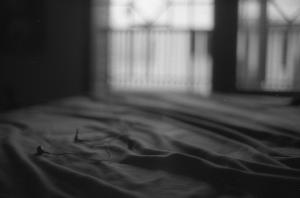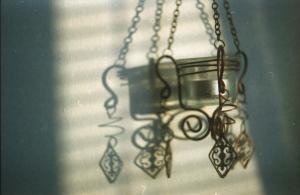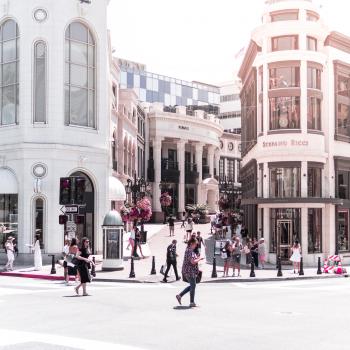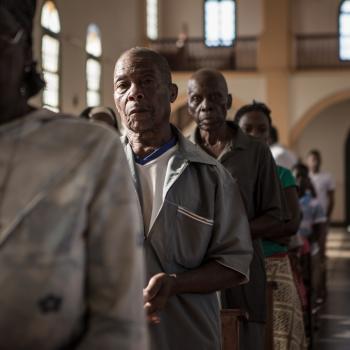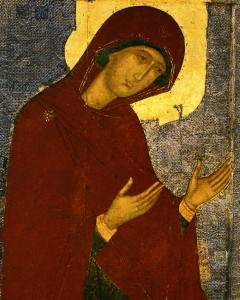 “One must have faith and pray; the water will have no virtue without faith.”
“One must have faith and pray; the water will have no virtue without faith.”
–St. Bernadette
My daughter just finished a week at our local Catholic school’s day camp. She came home with a crèche she made from a shoebox, a St. Brigid’s cross of pipe cleaners, and a plastic bottle of holy water, blessed by the deacon.
“It’s not from Lourdes,” the catechist told us, apologetically. For Catholics, the spring at Lourdes—dug by the bare hands of St. Bernadette at the urging of Our Lady— is the champagne of holy water. I think the batch my daughter brought home actually came from the water fountain in the school hallway. I was sitting out there with my toddler when the volunteers filled the plastic basin.
My own elementary school was named for Our Lady of Lourdes, and Mary was our patron and mascot to the point of insanity. My memories of religious education consist almost entirely of stories of Marian apparitions and miracles. Even slumber party games of Bloody Mary conjured images of a glowing lady in a cave, whispering secrets. One of my best friends had an actual glow-in-the-dark Mary I made her hide in a drawer when I slept over.
I wasn’t sure if Mary was to be feared or loved, but I definitely believed she had superpowers.
I was counting on those superpowers when I told my classmates, gathered at the lunch table on the second day of eighth grade, that my mother had lung cancer. I threw back my shoulders and proclaimed that it would be okay; we were going to get a miracle. That’s how I phrased it: get a miracle, as if miracles could be purchased at the shrine’s gift shop, plucked from the shelf right next to the finger rosaries and bottles of holy water.
I can still see those thirteen-year-old girls, frozen in a Last Supper tableaux, forks suspended halfway to their mouths, gazes directed at each other or at their plates, looking anywhere but at me. Miracles might happen to peasant children in Lourdes, Fatima, and Medjugorje. But coming from my own mouth, those words, get a miracle, sounded absurd.
My parents seemed neither to believe nor even recall the old Catholic school stories. At home, throughout those weeks of chaos and tears and strange casseroles cooked by the neighbors, a small vial of holy water from the spring in Lourdes sat atop our refrigerator, untouched, covered with the same layer of dust as the unpaid bills and the pack of cigarettes my grandmother left on one of her visits.
Instead, my parents were captivated by a book titled Healed of Cancer by Dodie Osteen, mother of Joel, the multimillionaire televangelist. Dodie had been diagnosed with liver cancer and told to go home and die, but had miraculously lived, and was cancer free. We gorged ourselves on her inspirational stories. We abandoned the Rosary for Dodie’s favorite Bible verses, our new mantras.
They still bob to the surface in times of need. I hear my dad whispering to us in the night, God has not given us a spirit of fear, but of power and of love and of a sound mind.
The Osteens called their Houston church “an oasis of love in a troubled world,” and it became the spring of hope for my mother in the short weeks when hope was still possible. On one of her many pilgrimages there, she felt the heat of Dodie’s hands running through her body and thought, it’s working.
Soon we all ended up in what appeared to be a Jacuzzi bathtub sunk into the altar—no, the stage—in the First Assembly of God on the I-10 service road in Slidell. It didn’t seem like too much to ask, to get saved. I would have eaten the grass and dug a spring in the mud too, like Bernadette, if she’d asked me to.
I had no knowledge of the Reformation, didn’t even know the word catechism. I’d never been anywhere but a Catholic church and had only the barest glimmer that there was any difference at all between being this kind of Christian or that kind of Christian except that here at the First Assembly it was definitely not okay to ask Mary to get your healing.
So we waded into the lukewarm water. I was last. The pastor smiled at me expectantly, then took my hand as if leading me to the dance floor. He braced my forehead and the small of my back, and then dunked me with surprising force. I remember being shocked that he wasn’t gentler, thinking, I’m only a child! I gasped and wiped my eyes as the music surged, and then, the applause.
My mother was waiting on the other side of the tub, clapping. She seemed so proud as I emerged dripping in my gym shorts.
But the world was unchanged. Same fluorescent lights. Same frizzy-haired lady changing the transparencies of the hymns on the overhead projector. Same felt banners with cotton-ball clouds. And my mother was still sick. It wasn’t working. None of it worked. Six months later, she was gone.
At bedtime on the last day of church camp, I opened my daughter’s holy water bottle, sprinkled a few drops on my fingertips and made the sign of the cross on her forehead, as the catechist had suggested. “The sign of the cross is a prayer in itself,” she’d said, scolding them gently for their sloppy execution. “You’re professing your belief in the trinity, so do it with some respect, please.”
As I blessed my daughter, she looked up at me, shyly, almost embarrassed. In her eyes I thought I saw a question: Do you really believe this stuff? Her own credulity often surprises me, makes me wonder at the responsibility of passing faith down to a child.
Do you really believe?
It’s not her question, but my own.


